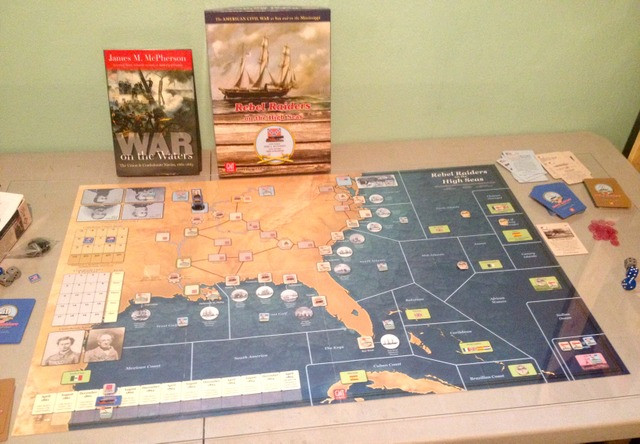I hate this cruise company! I’m never booking with them again!

I meant to report on this yesterday (the putative Tuesday Boardgame feature on this blog) but didn’t have time. Last week I described the GMT game Rebel Raiders On The High Seas, a strategic-level game about the American Civil War at sea.
My solitaire game ended in a blowout, with the Confederacy achieving a Sudden Death Victory in the Summer 1863 turn. By that point the Union had only captured four of twenty CSA Cities/Ports and had enjoyed a spell of terrible luck, losing several key battles to tied dice rolls. While the Union successfully took Norfolk, VA using the Sea to Shining Sea card, which allows two extra Amphibious Assaults in a turn, and had a clear shot at an undefended Richmond, the CSA had the Longstreet card, giving an extra assault die which rolled a “6”. The rebs win ties in Assaults, so old Pete saved Richmond and saved the Tredegar Ironworks, a key production centre for the CSA. At Vicksburg a small CSN flotilla and battery gutted Porter’s ironclads, while Farragut, with a mighty armada, crapped out at Mobile. A terrible turn and fairly typical of US dice luck. With six Raiders active at sea (including one that SANK a USN screw sloop in the Whaling Area - the only time a sloop CAUGHT a raider and it gets promptly sunk!), and several good turns by Blockade Runners, and the CSA maxed out its VPs, forced the Union to Fail a Resolve roll, and ended the game.
Half way through I realized I was doing a few things wrong. I didn’t realize that Union Screw Sloops (the blue water navy) take 2 turns to build and not just 1, which gave a USA advantage, but I also didn’t realize that one could assault a CSA Port/Fort even if it was defended by a Battery. Only CSN ships must be defeated first before an Assault. The Battery may be present, but it gives the CS player an extra assault dice to roll. That latter mistake was an advantage for the CSA, because the USN took heavy ship casualties trying to assault several positions with just batteries present.
After one complete play through, I have to say that I REALLY like this game. The cards are a satisfying source of chrome and historical flavour, and the game is a real challenge for both sides. For the Union, I think that the key to success in 1862 is to divert precious build points into buying extra assaults, since the USA MUST reduce the number of CS cities/ports early on if it is to have any chance. The blockade is great, but taking ports is the best way to defeat the Blockade Runners.
There will be a replay. I just unboxed another GMT game, A Distant Plain, Brian Train’s treatment of contemporary Afghanistan, so hopefully I’ll have something to say about that next week.
Blessings to your dice rolls! MP+

